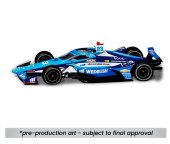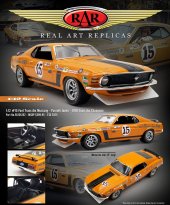Ferrari at Le Mans
1949–2023
Drivers and works entries – Statistics
The first win after the war – The early years 1949–1955
Start of a winning streak – 1956–1961
Spa was his passion, Le Mans his dream – Paul Frère
The Le Mans dream team – Phil Hill & Olivier Gendebien
The mid-engine prototype era 1961–1969 – From the Ferrari 246 SP to the 312 P
A very special year – The 1964 World Sportscar Championship
Victory for the underdog – The Ferrari 250 LM of Rindt/Gregory wins
at Le Mans in 1965
Swan Song – The last Ferrari sports prototypes at Le Mans 1970–1973
and many more!
- Ferrari 312 PB The last world champion prototype from Maranello
- Ferrari 365 GTB/4 Daytona The heavyweight
- Ferrari 512 BB Berlinetta Boxer
- Ferrari F40 1994–1996 Unfulfilled potential
- Ferrari 333 SP Not built for Le Mans
- Ferrari 550 Maranello The last 12-cylinder
- Ferrari 458 GT2 and 488 GTE The GTE years 2011–2022
- Ferrari 499 P Great expectations
When you think of Le Mans history, the likes of the Dunlop Bridge, the Mulsanne Straight, Maison Blanche, the ‘Prancing Horse’, Enzo Ferrari and the Testa Rossa all spring to mind. But you can’t forget the great American/Belgian driver duo of Phil Hill and Olivier Gendebien. Few others are associated as closely as the pair. It was their remarkably different social backgrounds that made them such a successful functioning driver unit. What they achieved between 1958 and 1962 hadn’t been accomplished before and hasn’t been matched since.
Phil Hill was born on 20 April 1927 to a middle-class family. He had one brother. Phil was an introvert; he had few friends and preferred to be alone. He loved classical music and learnt to play the piano. He also developed a fascination with cars at an early age. When he was 12, his favourite aunt bought him a Model T Ford, which he took apart several times to learn how it worked. His aunt’s chauffeur taught him how to drive. Hill dropped out of business school because he was bored. He preferred to learn about cars and took a job as a mechanic’s off-sider in a Los Angeles garage. The owner was an amateur racer. At 20 years of age, Hill acquired a two-seater MG TC which he modified and began racing in 1948. After the death of his parents in 1951, he purchased a second-hand 2.6-litre, 12-cylinder Ferrari 212 Export (chassis 0078E) from Luigi Chinetti, which he successfully raced. By the mid-1950s Hill had become the best sportscar racer in America.
Olivier Gendebien was born into a noble family on 12 January 1924 and grew up in Faulx Castle. But he and his six siblings weren’t raised like spoiled children. Olivier was introduced to horse riding by his father at an early age. It taught him a lot, such as empathy and how to take care of a horse. It was an experience that would benefit him greatly in later life. Gendebien had just graduated from secondary school when Germany invaded Belgium in 1940. During the war he joined the Resistance and went to England, returning to Belgium in September 1944, where he took part in the defence against the German Ardennes Offensive in the winter of 1944/1945. A year later he was discharged from the army and took up studies as an agricultural engineer…
Ferrari had won Le Mans five years in a row. Then, after a failed takeover of the Italian brand, Ford launched its own car, the GT40, which failed miserably on debut in 1964.
The following year Ferrari was looking to continue its dominance at Le Mans. Ford had reworked the GT40 and entrusted it with a new team in the hopes it could give Ferrari a run for its money. The rest of the competition merely played a supporting role in the 1965 edition.
A total of six brand-new Ford GT40s appeared at Le Mans in June. Spearheading the field were two prototypes of the second-generation GT40, called the Mark II. Shelby American had prepared the cars as the new Ford works team. They were fitted with 427-cubic inch big block V8s at Kar Kraft in Detroit. The remaining four Fords were powered by 325-cubic inch engines and entered by Rob Walker, Scuderia Filipinetti, FAV John Wyer and Ford France.
Ferrari countered the Ford armada with three factory prototypes, two four-litre 330 P2s and one 275 P2, supported by a 4.4-litre 365 P2 each from the North American Racing Team and Maranello Concessionaires. The five Ferraris and six Fords were considered the contenders.
In addition, Ferrari entered five 250 LM prototypes. The Berlinetta 250 LM wasn’t intended to fight for outright wins at major endurance races – that was the job of the ‘P’ prototypes. Instead, the 250 LM was to cover the GT class as the successor to the 250 GTO. But when the FIA refused to grant the car GT homologation, it had to run in the prototype category like its bigger brothers.
Basically, the 250 LM was a closed version of the 250 P. It shared the mid-engine design of the prototype as well as the 2.4-metre wheelbase and a number of body features. The first example was powered by the familiar three-litre V12 engine, hence the ‘250’ designation. The subsequent cars had the 3.3-litre engine. According to Ferrari’s system at the time, they should have been named ‘275 LM’, but officially the car retained its ‘250’ designation…
The years between 1970 and 1973 were the last during which Ferrari was involved in sportscar racing as a works team, and therefore represented the end of an era. The highlight of each of those seasons was the 24 Hours of Le Mans. Mauro Forghieri was the technical director during that period with Gianni Marelli as his second-in-command. The race team was relatively small by today’s standards, which made the fact that it ran four 512 Ss at Le Mans in 1970 and supported nine other privateer entries all the more impressive. That year Ferrari hired new people for the Le Mans effort, including Pietro Corradini whose insights serve as one of our sources for this article.
The organisation
Enzo Ferrari gave top priority to sportscar racing on the belief that the big endurance races, such as Le Mans, Daytona and Sebring, best demonstrated the quality of production cars. The revenue generated by these events helped fund the race team. According to Forghieri, from the early 1960s until 1970 the Scuderia was busier with its prototype programme than it was with Formula 1 every year until mid-June, and the lack of budget held the single-seater programme back. ‘From Enzo Ferrari’s point of view, winning Le Mans was worth as much as winning a championship,’ Forghieri later recalled. ‘Le Mans was an event that could boost a driver’s career and brought a lot of attention to the constructor and their production cars.’ Corradini points out that Ferrari’s first success had come in endurance racing: ‘Formula 1 came later. Endurance racing was undoubtedly very close to Enzo Ferrari’s heart. In his office in Modena, there was a photo of a Ferrari 312 P above his desk, not a Formula 1 car.’
But while Le Mans was enormously important to il Commendatore, he wanted to win everything, even the less-important races. As Corradini recalls, that expectation wasn’t just on the works drivers: ‘Once there was a race at Imola where journalists and mechanics competed against each other in the Fiat Ritmo 130. I represented the Ferrari mechanics. Enzo had doubts as to whether I was up to the task, and of course he wanted to win the race. Fortunately, I manged to do it. The Commendatore put pressure on everyone to succeed at every race.’…
Knowing that five-litre cars wouldn’t be eligible for the World Championship for Makes from 1972 onwards, Ferrari opted for a new three-litre, 12-cylinder prototype (project number 249) as early as 1971. The car was fundamentally different from the 312 P (project number 233) which was still in use in 1969.
The new car used the same flat engine as the Formula 1 car. It wasn’t a boxer engine in the truest sense, but a V12 with a 180-degree bank angle. The basic features of the motor were based on the 1.5-litre engine from 1964 and the two-litre unit Peter Schetty had used to win the 1969 European Hillclimb Championship in the 212 E. The engine was designed by Mauro Forte and then adapted by Mauro Forghieri for long-distance racing. In particular, the entire cooling system was revised with three openings at the front alone, two of them on the side for the brakes. The radiators were located to the side of the engine, and air came through ducts in the doors. The oil coolers were located on the clutch housing, the transmission oil cooler behind the transmission.
The body was small and delicate with a total weight of just over 650 kilograms. The first factory specs had that as low as 585 kilograms. The wheelbase was very short, 2,22o millimetres, which underpinned the car’s excellent handling. The power output was listed as 440 horsepower at 10,800 rpm in endurance spec, compared with 470 horsepower at 12,600 rpm in Formula 1 spec. For Ferrari it was clear from the outset that the engine was designed for distances of 1,000 kilometres or six hours, and wasn’t intended for a 24-hour race.
Initially, Ferrari did not use the PB name. According to the naming system, the car should have been called the ‘312 Boxer Prototype’ – or 312 BP. However, Enzo Ferrari is said to have exclaimed: ‘How can I call it BP when we are contracted to Shell?’ Over time, however, Ferrari started using ‘PB’, which journalists had coined to differentiate the car from the 1969 Ferrari 312 P and to avoid confusion with oil company BP…
This product was added to our catalog on Friday 23 February, 2024.




